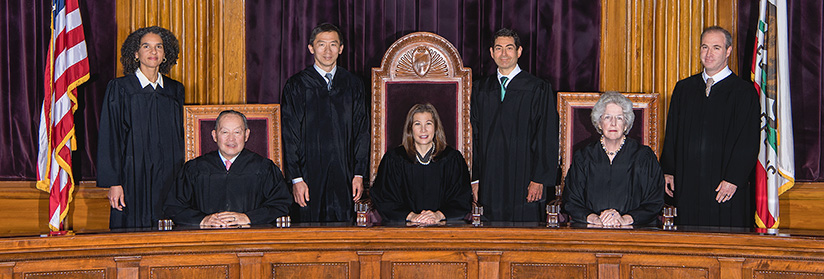
California Supreme Court Cuts Pension ‘Air Time,’ but Preserves ‘California Rule’
High Court ‘missed an opportunity to resolve California’s massively underfunded pension obligations’
By Katy Grimes, March 4, 2019 12:57 pm
The California Supreme Court announced its long-awaited decision on pension spiking and the purchase of “air time” credits Monday. In an unanimous ruling, the court found that state government may legally rescind the purchase of “air time” credits, a practice where public employees nearing retirement can purchase more years of service applied to their pensions, significantly boosting the pensions. But, the high court decided not to touch the controversial “California Rule,” which states that once a public employee receives a pension benefit, it can never be reduced unless that employee receives something of equal or greater value.

Some pension experts are saying the high court is splitting the baby by punting the decision on the California Rule.
Increasing public employee pension costs paid by residents of municipalities are seeing ever-higher taxes and realizing fewer services – but for how long?
Under California law, pensions are treated as contracts, and protected by the California Constitution. The “California Rule” remains the barrier for any efforts to reduce pension costs, in that it severely limits public agencies’ efforts to slice current pension costs.
The decision stems from a 1999 law that started a tsunami of retroactive pension increases “predicated on the idea that stock-market increases would endlessly pay for all those six-figure pensions and spiking gimmicks,”wrote Steven Greenhut, author of Plunder! How Public Employee Unions are Raiding Treasuries, Controlling Our Lives and Bankrupting the Nation. “But what goes up most come down. Instead, the state’s pension funds are dangerously underfunded and localities are slashing services to pay for golden retiree deals.”
In the decision, the court said, “We conclude that the opportunity to purchase ARS credit was not a right protected by the contract clause,” referring to purchases of “air-time.”
The case, CAL FIRE LOCAL 2881 v. CALIFORNIA PUBLIC EMPLOYEES’ RETIREMENT SYSTEM, challenged one of the provisions of the 2013 California Public Employees’ Pension Reform Act, known as the Public Employee Pension Reform Act (PEPRA), Governor Brown’s pension reform legislation, in which the plaintiffs argued against PEPRA’s abolition of “air time” credits.
“The simple argument made by the Brown legal team is eliminating airtime does not violate the rule,” Greenhut explained. “It was never meant as a taxpayer-funded benefit (it was supposed to pay for itself). When the Legislature created it in 2003, it never ‘intended to extend an irrevocable offer to purchase airtime and prevent future legislators from adjusting benefits for the fiscal health of the state’s pension system.’”
Nearly all pension experts say that without significant top-down reforms, pension payments can and will likely bankrupt California’s state and local governments. California’s major pension funds have already announced that payments required from participating agencies are going to roughly double in the next six years. This is a best-case scenario, and it is already more than many cities and counties are going to be able to afford.
Since a California Supreme Court decision in 1955, California has adhered to “The California Rule” guaranteeing public employees the pensions in place the day they were hired. The California Supreme Court had the opportunity to overturn the California Rule, which would not have affected the pension benefits existing employees earned to-date, but would have allowed important changes going forward.
California has had several cities file bankruptcy in recent years:Vallejo, Stockton, San Bernardino and Mammoth Lakes, but dodged the opportunity to address pension obligations in federal bankruptcy court.
Sen. John Moorlach (R-Costa Mesa), weighed in on the decision:
“Granting future benefits should not be an elevator that only goes up. While the California Supreme Court settled the case before them – ruling that what the legislature gives, it can take away as long as it is not unconstitutional – it did not give direction on how this court would deal with the California Rule as it applies to so many other cases. This half loaf result leaves elected officials to still wonder what is unconstitutional about negotiating reduced pension benefits going forward. And California State, school and municipal governments will continue to face ever-growing massive unfunded pension liabilities. This may endanger the retirement income of all current and future pensioners.
Carl DeMaio, the author of the San Diego Pension Reform Initiative, also weighed in:
“In the narrow ruling that upheld the elimination of the right to purchase service credits to spike pensions, the justices opted to leave the problematic ‘California Rule’ intact that has been a legal barrier to meaningful reform to unsustainable pension benefits. Specifically the Supreme Court ruling said “We have no occasion in this decision to address, let alone to alter, the continued application of the California Rule,” the court said in the decision. The California Rule has been used repeatedly by politicians and government union bosses to block pension reform.
Pension expert, President of California Foundation for Fiscal Responsibility, and primary consultant to Gov. Brown on the 2013 PEPRA reform, Marcia Fritz has more questions right now than answers. In a brief discussion Monday following the decision, Fritz said:
“Teachers have a basic pension benefit formula of 2% of final wages at age 60, and it increases to 2.4% at age 63–a 20% premium, in addition to three additional service years. Is the pension premium for older teachers a ‘core’ benefit guaranteed by the state legislature?”
“There are at least a dozen other pension enhancements beyond the ‘core’ benefits granted to workers before PEPRA that may be impacted by this decision,” Fritz said. “Examples include pensions based on final salary vs. an average of three to five years; pensions based on final wages that included elements of pay beyond base pay (particularly for safety workers), spousal benefit guarantees at bargain prices, adding the employer ‘pick up’ of the employee share of pension contribution to final pay when calculating his/her pension, reciprocity when a worker leaves one agency and works for another without capping their pension earned from the previous employer, etc. Many of these enhancements were permitted by the legislature, but implemented by statute using actuarial assumptions that were somewhat aggressive, which sugar coated the market risk, and turned a blind eye on games that could be played to enhance pensions and shove costs to future taxpayers.”
Fritz also asked, “Was the retroactive portion of benefit formula enhancements (vs. prospectively) a CORE benefit?”
“Since the California Supreme Court punted on the vested right issue and looked solely to contract law, can’t we use the same law to modify contracts?” Fritz asked. “They used strong words–‘deferred compensation’ and ‘core benefit.’ Are retroactive benefit formula enhancements, reciprocity, spousal benefits at a bargain price, longevity formula increases, reduced retirement ages, pensions based on final pay (vs average 3 yrs), etc. ‘deferred compensation,’ ‘core benefit’ or contractual (’til death do us part) guarantees? Can a contract unduly encumber future generations who received no benefit in return?”
There is clearly so much still to be digested in this decision.
- California Lawmaker Making the State More Hostile to Business - April 18, 2024
- California Democrats’ Backdoor Reparations Scheme - April 17, 2024
- California’s Senate Democrats Reject Bill to Make Purchasing a Child for Sex a Felony - April 16, 2024





“Teachers have a basic pension benefit formula of 2% of final wages at age 60, and it increases to 2.4% at age 63–a 20% premium, in addition to three additional service years. Is the pension premium for older teachers a ‘core’ benefit guaranteed by the state legislature” It is when they placed in the contract they proposed to the teachers. If they didn’t want to support their offer, I would call that ‘bad’ bargaining. What good is an employee contract if the employer can change it whenever they want???